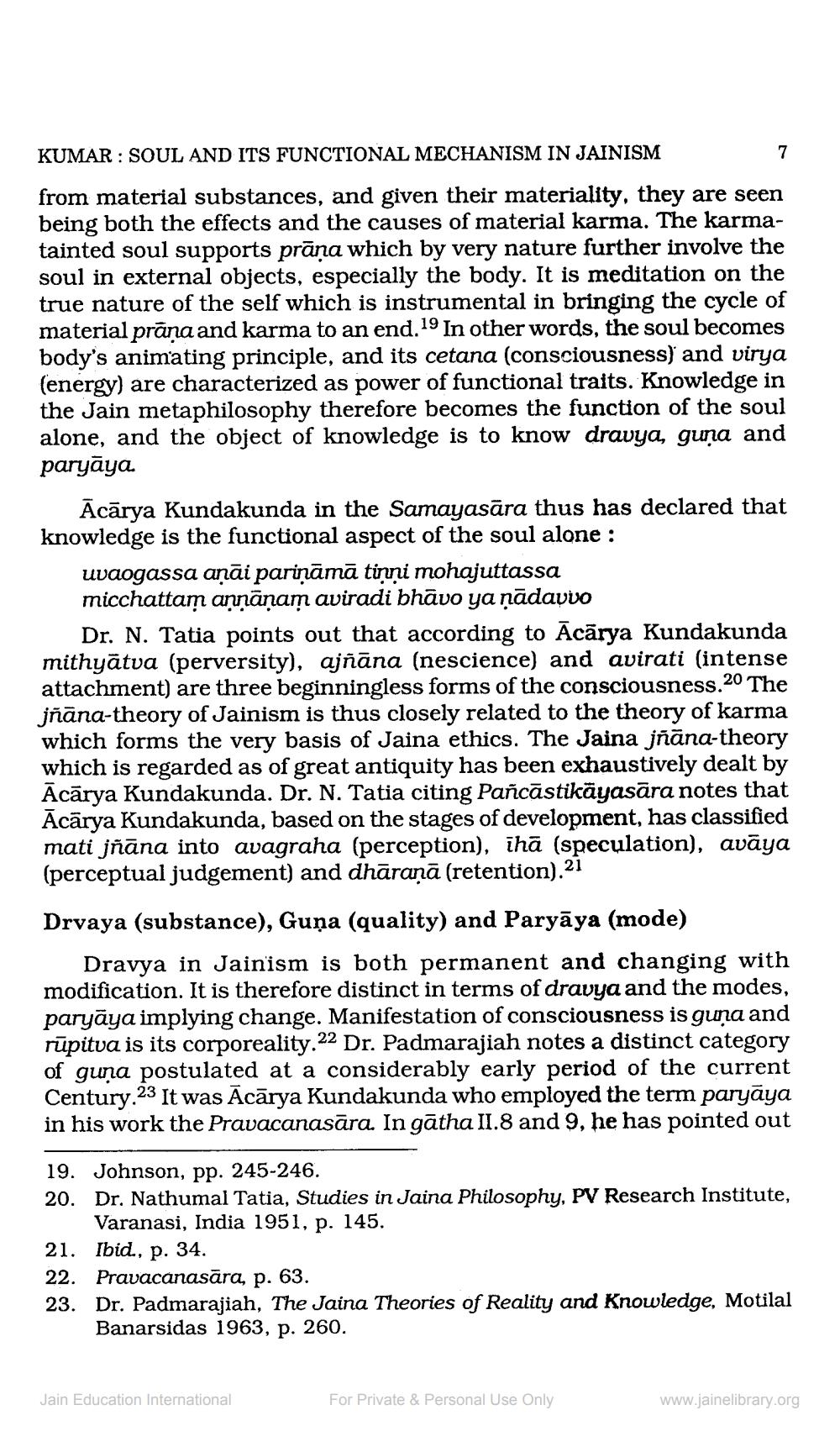Book Title: Jain Journal 2000 07 Author(s): Jain Bhawan Publication Publisher: Jain Bhawan Publication View full book textPage 9
________________ KUMAR : SOUL AND ITS FUNCTIONAL MECHANISM IN JAINISM from material substances, and given their materiality, they are seen being both the effects and the causes of material karma. The karmatainted soul supports prāna which by very nature further involve the soul in external objects, especially the body. It is meditation on the true nature of the self which is instrumental in bringing the cycle of material prāna and karma to an end.19 In other words, the soul becomes body's animating principle, and its cetana (consciousness) and virya (energy) are characterized as power of functional traits. Knowledge in the Jain metaphilosophy therefore becomes the function of the soul alone, and the object of knowledge is to know dravya, guna and paryāya Ācārya Kundakunda in the Samayasāra thus has declared that knowledge is the functional aspect of the soul alone : uvaogassa aņāi pariņāmā tinni mohajuttassa micchattam annāņam aviradi bhāvo ya ņādavvo Dr. N. Tatia points out that according to Ācārya Kundakunda mithyātva (perversity), ajñāna (nescience) and avirati (intense attachment) are three beginningless forms of the consciousness.20 The jñāna-theory of Jainism is thus closely related to the theory of karma which forms the very basis of Jaina ethics. The Jaina jñāna-theory which is regarded as of great antiquity has been exhaustively dealt by Ācārya Kundakunda. Dr. N. Tatia citing Pañcāstikāyasāra notes that Ācārya Kundakunda, based on the stages of development, has classified mati jñāna into avagraha (perception), ihā (speculation), avāya (perceptual judgement) and dhāraṇā (retention).21 Drvaya (substance), Guņa (quality) and Paryāya (mode) Dravya in Jainism is both permanent and changing with modification. It is therefore distinct in terms of dravya and the modes, paryāya implying change. Manifestation of consciousness is guna and rūpitva is its corporeality.22 Dr. Padmarajiah notes a distinct category of guna postulated at a considerably early period of the current Century 23 It was Ācārya Kundakunda who employed the term paryāya in his work the Pravacanasāra. In gātha II.8 and 9, he has pointed out 19. Johnson, pp. 245-246. 20. Dr. Nathumal Tatia, Studies in Jaina Philosophy, PV Research Institute, Varanasi, India 1951, p. 145. 21. Ibid., p. 34. 22. Pravacanasāra, p. 63. 23. Dr. Padmarajiah, The Jaina Theories of Reality and Knowledge, Motilal Banarsidas 1963, p. 260. Jain Education International For Private & Personal Use Only www.jainelibrary.orgPage Navigation
1 ... 7 8 9 10 11 12 13 14 15 16 17 18 19 20 21 22 23 24 25 26 27 28 29 30 31 32 33 34 35 36 37 38 39 40 41 42 43 44 45 46 47 48 49 50
